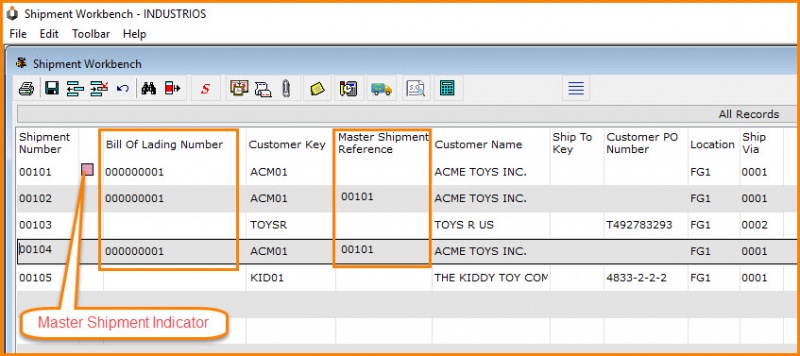How to Consolidate a Bill of Lading
We know that shipment paperwork is often not tied to the sequence of the related sales orders. Orders can be shipped in a sequence and line combination that's very different from the original orders. The Consolidated Bill of Lading allows you to generate shipping documentation to support consolidation but preserve the ability to invoice orders separately.

Before you start: Consolidations can be created automatically when you create shipments within INDUSTRIOS. If the shipments already exist, they can be manually consolidated.
Here's how to consolidate shipments automatically during shipment creation
-
Navigate to Sales | Sales Order Fulfillment | Transaction Processing | Shipping Requirements - Sales Order.
-
Tag the orders that you are shipping.
-
Click the Create Shipment button; update the committed quantities and then click Create to launch the Create Shipment wizard.
-
Select the Consolidate Bill of Lading checkbox.
-
Choose the Primary Basis for Consolidation (Customer, Customer.Ship To, or Sales Order Number). If necessary, you can select a secondary basis for consolidation.
-
Click Process. Any shipments that meet the criteria will be consolidated.
If shipments have already been created they can be consolidated manually. Here are the steps to manually consolidate shipments:
-
Navigate to Sales | Sales Order Fulfillment | Transaction Processing | Shipment Workbench.
-
Click the Update button on the Shipment Workbench and select Consolidate Bill of Lading. Note that the Update button can also be used to Unconsolidate shipments.
-
Identify which shipment should be the master shipment. The master shipment will be updated with the lines from the other shipments tagged for consolidation.
-
The same Primary and Secondary bases for consolidation that were available for automatic consolidation are available when manually consolidatiing shipments.
-
Click Process to run the consolidation process.
-
See the screen below for Bill of Lading and Master Shipment references on the Shipment Workbench.






